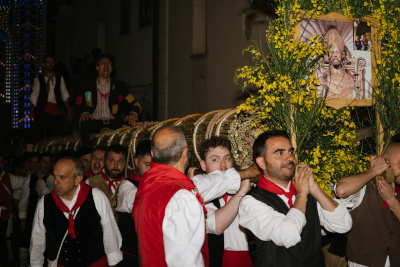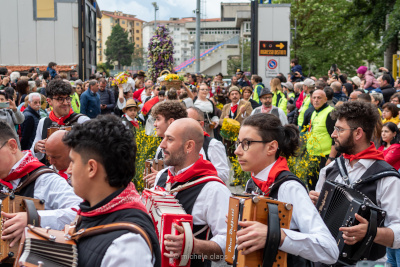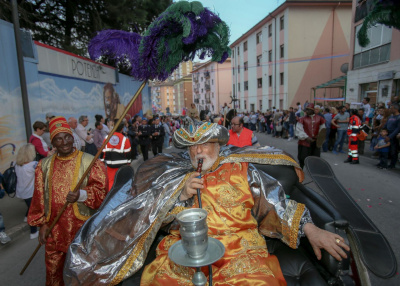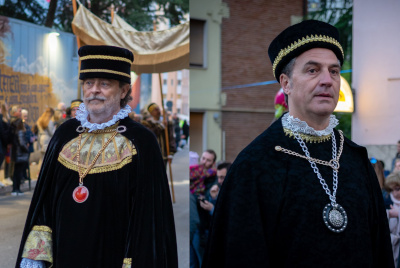Characters
Characters and Components

The Parade shows a huge variety of figures and costumes, so it is impossible to resume an extensive description of each component. In the following, we will focus on the key figures of the Parade, many of those have been already introduced in their respective roles in the previous Pages who discussed in details Frameworks and Sections of the Parade.
The “Cinti” (Opening of the First Framework)
The “Cinti” are devotional simulacra formed by flowers and other decorative natural elements, they are handcrafted in the hours preceding the Parade. The are brought by shoulders during the Parade by peasants. They symbolize the popular devotion toward the Saint, to whom the most beautiful inflorescences of the Spring period were given, including the flowers symbol of the Parade: the yellow gorse.

Iàccara and Portatori (First Framework)
The Iàccara is an element that recovers and preserves the tradition of the "devotional bundles" that were burned in the night of the Parade. It is an artefact consisting of bundles of rods and branches intertwined with each other, about 10 meters long with a weight of about 900/1000 kilos. It is handcrafted in the days preceding the Parade and is brought by shoulders by “Portatori della Iàccara” (Bearers of the Iàccara). Before the end of the procession, the Iàccara reaches Piazza del Sedile where it is stacked vertically, subsequently the boss of “Portatori della Iàccara” climbs the artefact till the top were it is fired. The Iàccara is a fundamental element of the Parade, it perpetuates an ancient tradition, already described by Raffaele Riviello with these words:
"...Nella vigilia, in sull’ora del vespero, si portavano in città, a suono di pifferi, di tamburi, o di bande, le iaccare (fiaccate), cioè grandi falò, fatti di cannucce affasciate attorno attorno ad una trave sottile e lunghissima, per divozione di qualche bracciale possidente, di proprietario vanitoso, o per incarico dei Procuratori della festa.” Raffaele Riviello

Paesants (First Framework)
Figures who provide a picture of the Potentine people of the time, cheerful and happy for the celebration of the anniversary of the Saint. The Parade was a unifying moment that raised the people for a few hours by the hard work in the fields or workshops.

Nobles of Nineteenth Century (First Framework)
The first framework is closes by several figures which represents the nobles and middle class of nineteenth century. They stand out for elegant and refined costumes. Together with other components of the first framework the provide a picture on the Potentine social structure of the time.

Turks and C’vuddinè (Second Framework, Section 1)
This section gives a picture of the social structure of Turkish people, together with soldiers, odalisques (woman dancers), and other figures of the Ottoman nobility with the Great Turk "C’vuddinè", a political-religious leader.

Latin swordsmans or City Guard (Second Framework, Section 2)
A group of soldiers representing the City Guard and the “occidental” armies, they stage together with Turkish army a fight in Piazza XVIII Agosto who ends with weapons deposition, a great message for peace.

The Ship of San Gerardo (Second Framework, Section 3)
The Ship, a crucial component with multiple meanings, carries the transfiguration of a “Child San Gerardo” who blesses the People. The ship is manually handed by Turkish plebs.

Potentine nobility (Second Framework, Section 4)
The nobles and the middle class follow the Ship of San Gerardo after the salvation of the City (miraculous episode already described), these figures parade in typical dresses of Middle Ages, characterized by bright colours and elegant shapes.

Mastro Giurato & Count De Guevara (Second Framework, Section 5)
The Mastro Giurato and the Count Don Alfonzo De Guevara are very important figures of the Parade, in Porta Salza it is staged the ceremony in which Mastro Giurato (the old magistrate of the city) delivers the key of the City in the hands of the Count, so entrusting Potenza and its citizens to the new Count.

Portatori del Palio (Second Framework, Section 5)
Another fundamental component of the Parade: the Palio of San Gerardo is a wide drape sustained by spars manually carried by six figures (Bearers of the Palio). It follows the procession soon after the Mastro Giurato and Count Don Alfonso De Guevara. This component is of great importance as it is mentioned in the official document of 1578 a.C. drawn up by the notary Scafarelli.

Church men (Third Framework)
This is the religious component of 1100 a.C., highlighting the deep devotional characters of this framework. Several figures with monastic clothes take part to the procession quietly, someone seems to pray.

Knights of San Giovanni di Gerusalemme (Third Framework)
Monastic-knightly Order founded to protect Christian faith and faithful, in particular the pilgrims during the journey toward the Holy Land and in general all oppressed Christians.

The Temple of San Gerardo (Third Framework)
The temple of San Gerardo, a wooden canopy that conveys the figure of the Patron Saint, symbolizes its earthly presence in the Parade. It is led by the shoulder by “Portatori del Santo” (Bearers of the Saint) in the very last component of the Parade, thus closing the procession.

